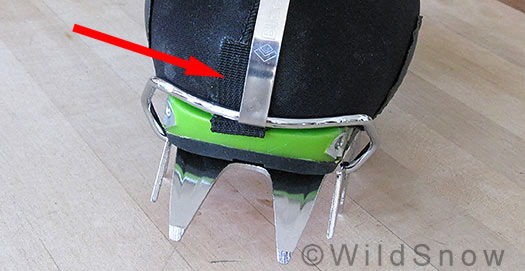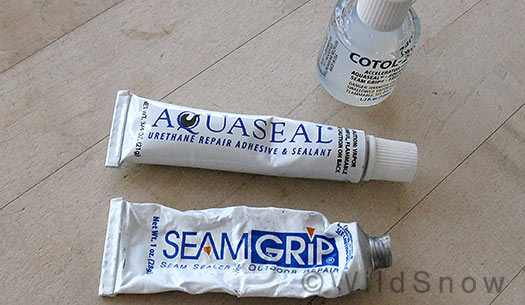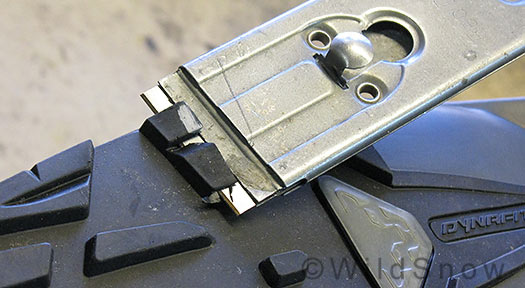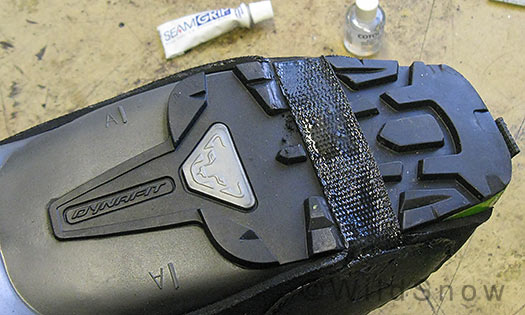
I’ve been struggling with making sure my feet don’t come back in pieces from our Alaskan sojourn. The weather can be manageable on Denali in June, but then, your summit day can also involve little party favors such as a 30 below zero Fahrenheit breeze. It’s tough to keep your feet warm in those kinds of temps. Because no matter how much you punch out a ski boot, and no matter how many sock layers it then holds, you’re still talking mere inch fractions of insulation.
Think about it. In those kind of temps you might wear a parka with three puffy inches of loft, and you expect your feet to stay warm with three sixteenths of an inch? That’s why overboots are popular for arctic mountaineering.

Boot Glove by Dry Guy is a clever option for colder temperatures. I'll probably bring a pair to Denali, with some modifications for climbing use.
Thing is, overboots such as the well known models from 40-Below are beautifully made but somewhat bulky for something I might only use for a few days up high. They’re also difficult to configure for Dynafit bindings, and thus might require one to use the “climb with ’em on, take ’em off to ski” method of use. That sounds like a hassle to me, but I’ll do it if necessary. Another option are the neoprene boot covers known as Boot Glove by Dry Guy. I’m currently in a dilemma about which to use, 40-Below overboot or Boot Glove, so I figured I’d do my best to configure both options then go do some testing. Today, the Boot Gloves.
Boot Glove is a simple neoprene cover that stretches over the toe area of your boot. The front is held down by a single strap under the sole of the boot, with the rear tensioned and attached by a velcro strap that goes behind your ski boot heel. In similar fashion to the “super gaiter” concept, the weak point of this system is holding down the “glove” over your boot toe. Upside is that when used with crampons such as Black Diamond Switchblade, the crampon strap system holds the glove toe down just fine. In my case, since I usually remove the toe strap system on such crampons, I added a webbing tab on the front of the glove that fits under the crampon bail and provides hold-down attachment.

This photo shows the webbing tab I added to the Boot Glove toe cap for 100% hold down with crampons on.
Even with my mods, how do you hold down the Boot Glove over your boot toe when not wearing crampons but still doing things like post holing in deep snow or breaking trail while backcountry skiing in deep powder? I’m pretty sure the answer is to use some sort of reversible adhesive, perhaps a dab of skin glue, or to use something with inherent friction such as coating both the boot toe and inside of Boot Glove with urethane seam sealer. Speaking of which, in doing all our gear repairs and mods for Denali, I’ve been going through gallons of Seam Grip and Aqua Seal. The stuff is like duct tape in a bottle. To add durability to the Boot Glove, I’ve slathered urethane all around the rand, and built up a thick coat on the strap that goes under the boot sole. Before we step onto the Kahiltna Glacier, I’ll also use it on numerous other wear points found on our tents, gloves, sleeping bags or wherever. Terrific stuff.

Aqua Seal and Seam Grip are liquid duct tape. They take a while to dry unless you use the available accelerator. Aqua Seal comes out of the tube as more of a gel, Seam Grip is more liquid. Both versions have their uses. For building up a layer for durability the gel works better, but if you want liquid penetration for strengthening stitching, Seam Grip is the choice. Either way, wear disposable latex gloves and your work clothing.
I don’t envision holding down the Boot Glove toe to be a problem while in skis, only while booting without crampons. Also, duct tape exists, or once up high I could even glue the toe of the Boot Glove to my boot toe with Seam Grip. Yes, I tested and Seam Grip is one of the few things I’ve found on the planet that will stick to pebax ski boot plastic. Thus, I’m thinking I can make the Boot Gloves work for Denali.

Boot Gloves are designed for smooth soled alpine boots. Randonnee sole lugs prevent the cross-strap from riding back to the point of properly tensioning the stretchy neoprene. Nothing a bit of knife work can't cure. For insurance, I'm thinking of adding another strap that goes under the boot instep.

The Boot Glove kit comes with heat reflective aluminized plastic tape they recommend layering on your boot liner toe. An aluminized insole cover is also included. I'll use the insole, but am not sold on the toe covering for my randonnee boots since you do get some solar heating through thin translucent pebax, and in testing I noticed little if any difference between one liner with the tape and one without.
In closing, note that I’ve made great effort to modify and fit my Denali ski boots so they’re extra warm for backcountry skiing. In other words, I’m not using the Boot Glove or overboots to compensate for a poorly fitted ski boot without enough insulation. Instead, they are an enhancement. Hopefully, even a tropical delight. And yes, the Boot Glove is a proven alpine skiing accessory so if you get cold feet at the resort, try a set.
WildSnow.com publisher emeritus and founder Lou (Louis Dawson) has a 50+ years career in climbing, backcountry skiing and ski mountaineering. He was the first person in history to ski down all 54 Colorado 14,000-foot peaks, has authored numerous books about about backcountry skiing, and has skied from the summit of Denali in Alaska, North America’s highest mountain.

